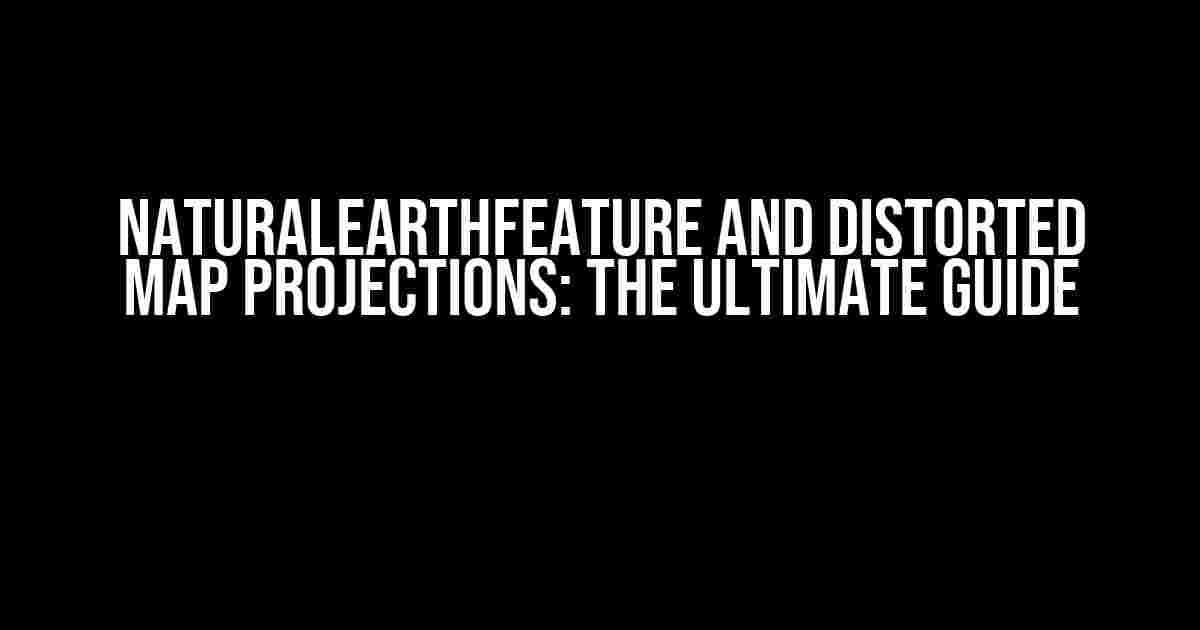Are you struggling to get your NaturalEarthFeature to display correctly with certain map projections? You’re not alone! In this comprehensive guide, we’ll explore the common issues, solutions, and best practices to ensure your NaturalEarthFeature shines on any map.
What is NaturalEarthFeature?
NaturalEarthFeature is an OpenSource data set that provides a wide range of map features, including countries, coastlines, rivers, and more. It’s a powerful tool for creating stunning maps, but sometimes, it can be finicky when paired with certain map projections.
What are Distorted Map Projections?
Map projections are mathematical ways to represent the curved Earth on a flat surface. Some projections, like the Mercator projection, are notorious for distorting certain areas, making them appear larger or smaller than they actually are. These distortions can wreak havoc on your NaturalEarthFeature, causing it to display incorrectly.
The Problem: NaturalEarthFeature and Distorted Map Projections
When combining NaturalEarthFeature with distorted map projections, you might encounter the following issues:
- Features appear stretched or squished
- Boundaries overlap or intersect incorrectly
- Labels are misplaced or hidden
- Features disappear or are cutoff at the edges
Why Does This Happen?
The root of the problem lies in the way NaturalEarthFeature handles coordinate systems and transformations. When a distorted map projection is applied, the coordinates get warped, causing the NaturalEarthFeature to display incorrectly.
Solutions and Workarounds
Fear not, dear cartographer! There are ways to overcome these challenges and get your NaturalEarthFeature to display correctly, even with distorted map projections:
1. Choose a Less Distorted Projection
Sometimes, switching to a less distorted map projection can solve the problem. Look for projections that preserve shape and size, like the Winkel Tripel or the Azimuthal Equal-Area projections.
2. Use a Coordinate System Transformation
Transform your NaturalEarthFeature coordinates to match the distorted map projection. This can be done using libraries like GDAL or proj.4. Here’s an example using Python and GDAL:
from osgeo import ogr
# Set the input and output coordinate systems
input_crs = 'EPSG:4326' # WGS 84
output_crs = 'ESPG:3857' # Web Mercator
# Create a transformation object
trans = ogr.osr.CoordinateTransformation(input_crs, output_crs)
# Transform the NaturalEarthFeature coordinates
for feature in natural_earth_features:
geom = feature.GetGeometryRef()
geom.Transform(trans)
3. Apply a Scale Factor
For projections that stretch or shrink features, applying a scale factor can help. This can be done using a spatial reference system (SRS) string or by setting a custom scale factor in your mapping library.
| Projection | Scale Factor |
|---|---|
| Mercator | 0.5 to 2.0 |
| Winkel Tripel | 1.0 to 1.5 |
4. Use a Custom Map Projection
Create a custom map projection that minimizes distortions in your area of interest. This might require advanced cartographic skills and specialized software, but it can provide the most accurate results.
5. Split or Union Features
For features that are cutoff or overlap at the edges, try splitting or unionizing them using a GIS library or software. This can help remove unwanted artifacts and improve display quality.
BONUS TIPS AND BEST PRACTICES
To ensure your NaturalEarthFeature displays correctly, follow these best practices:
- Use high-quality NaturalEarthFeature data: Make sure you’re using the latest, most accurate data from the NaturalEarthFeature repository.
- Choose the right map projection: Select a projection that suits your map’s purpose and audience. Consider the level of distortion, accuracy, and aesthetics.
- Test and iterate: Experiment with different projections, scale factors, and transformations to find the best combination for your NaturalEarthFeature.
- Keep it simple: Avoid over-complexifying your map with too many features, labels, or annotations. This can help reduce visual clutter and improve performance.
- Stay updated with cartographic advancements: Keep an eye on new developments in map projections, coordinate systems, and NaturalEarthFeature data to stay ahead of the curve.
Conclusion
NaturalEarthFeature and distorted map projections don’t have to be enemies. By understanding the challenges and applying the solutions and workarounds outlined in this guide, you can create stunning, accurate maps that showcase your NaturalEarthFeature in all its glory.
Remember to choose the right map projection, apply coordinate system transformations, scale factors, and custom projections when needed. Don’t be afraid to experiment, iterate, and seek help from the cartographic community. Happy mapping!
Frequently Asked Question
If you’re having trouble getting NaturalEarthFeature to display correctly with certain map projections, you’re not alone! We’ve got the scoop on what’s going on and how to fix it.
What’s the deal with NaturalEarthFeature not displaying correctly with certain map projections?
It’s all about the math, baby! NaturalEarthFeature uses a specific geographic coordinate system, which can get distorted when displayed on certain map projections. Think of it like trying to flatten a globe onto a 2D surface – some things are gonna get a little wonky.
Which map projections are causing the trouble?
The usual suspects are cylindrical projections like Mercator and Gall-Peters. These projections stretch and squish the Earth’s surface in ways that can make NaturalEarthFeature go haywire. But don’t worry, there are workarounds!
How can I avoid distorted NaturalEarthFeatures on my map?
Easy peasy! Just switch to a more, shall we say, “projection-friendly” coordinate system. Azimuthal projections like the Azimuthal Equidistant or the Orthographic projection tend to play nicer with NaturalEarthFeature. Give it a try and see the difference!
Can I still use Mercator or Gall-Peters if I really want to?
Technically, yes. However, be prepared for some funky business going on with your NaturalEarthFeature. If you really need to use one of these projections, try experimenting with different rendering scales or applying some creative styling to mitigate the distortion. Just don’t say we didn’t warn you!
Are there any other tips for working with NaturalEarthFeature and map projections?
Absolutely! When in doubt, consult the NaturalEarthFeature documentation and map projection resources. Experiment with different combinations to find what works best for your map. And don’t be afraid to get creative and try new things – after all, that’s what mapping is all about!

